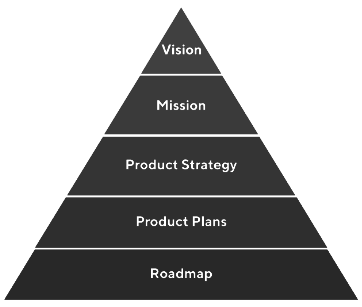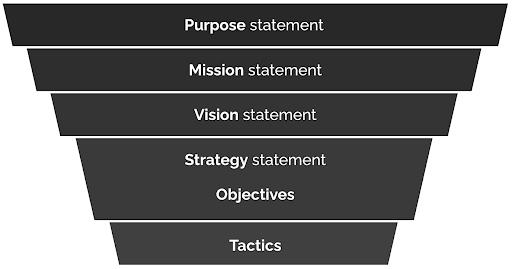Are you a product leader looking for a way to guide and inspire your team? Or perhaps you’re a product manager looking for a way to evangelize your plan effectively. You may even be a founder or entrepreneur who wants to establish a foundation for many critical decisions to come.
No matter where you’re at, you’re not alone. For many, product strategy feels like a mystery, and there’s no standard definition or method.
In this guide, I’ll do my best to demystify product strategy and outline a product strategy framework to help you guide your team to success.
Table of contents
- What is product strategy?
- A modern product strategy framework for agile teams
- What are the benefits of a product strategy framework?
What is product strategy?
A product strategy is a lasting yet dynamic decision-making framework that will guide the business model, teams, individuals, and entire organizational culture toward long-term success.
A good product strategy starts with a high-level purpose that rarely, if ever, changes and narrows down to the day-to-day agile execution of self-organizing teams, which will change often. A good strategy motivates and provides clarity for teams.
The traditional product strategy pyramid
The traditional way to picture product strategy is with a pyramid.

In my opinion, this model doesn’t effectively illustrate what a product strategy does or how to define it.
For one thing, pyramids start at the bottom, not the top. Presumably, vision and mission are situated at the top of the pyramid because they are the most important — but isn’t the foundation really the most important part of a pyramidal structure? Why would a tactical step such as roadmapping be pictured as a foundation or starting point of anything?
Regardless, the good news is that we’ve learned a great deal about digital product development over the years. Today, we know that roadmaps and tactics are not a good foundation for a product or company strategy.
The product strategy funnel
A sound product strategy is one that resembles not a pyramid, which promotes constantly building more and more and more, but a funnel that guides the team step by step with increasing clarity at each stage.
That’s right — product strategy is not about doing things. It’s about knowing what not to do.
I’ve been greatly inspired by Martin Eriksson from Mind the Product, who talks about a model he calls the decision stack, where familiar elements such as product vision and objectives are simply decisions that help us narrow down our choices.
As Steve Jobs once said, “I’m actually as proud of the things we haven’t done as the things I have done. Innovation is saying no to 1,000 things.”
A modern product strategy framework for agile teams
This product strategy framework consists of six levels: purpose, mission, vision, strategy, objectives, and tactics.

Be concise (1–3 sentences), bold, positive, and inspiring when developing these ideas. Especially for the higher-level statements, communicate how your product will aim to make the world a better place for the benefit of your team members, partners, and customers.
Let’s explore each level of this product strategy framework in detail with examples.
Purpose statement
The purpose statement is set at the company level. It is the highest-level “why” of the business: Why does the business or product exist? It should be broad enough to separate itself from specific “whats” (i.e., solutions) but narrow enough to accurately reflect how the company sees itself.
The purpose statement should be no longer than one sentence long. Ideally, the purpose will never change.
Purpose statement example
We are here to help people accomplish their dreams.
Despite the breadth of this purpose, we still have endless room to explore and evolve.
In this example, we’ve already narrowed down the things we will pursue. To stay true to the purpose statement, we’ll need to say no to many things.
Mission statement
How do we plan to pursue our purpose? If the purpose is the highest-level “why,” the mission is our highest-level “how.”
The mission may never change, but it could change with significant customer needs or technology changes.
Mission statement example
We will provide solutions that help all people progress, grow, and find satisfaction in their work.
In this example, we pledge to provide “solutions,” but the language is intentionally vague. These could be scaled technology solutions or more personalized solutions.
The term “work” is also deliberately vague. This statement suggests that we believe people want to find value in their activities, even if it isn’t a traditional career or paid service, regardless of their age, location, or economic status.
Vision statement
At this point, we’ve made a few decisions. We know why we exist (purpose) and, broadly, how we plan to take action (mission). Now, we’ll define what our product should look like if we live up to our purpose and mission statements.
Your product vision statement is the highest-level “what,” designed to give ongoing direction and motivation to the team. A vision may last several years and change slightly over time.
A good product vision statement is aspirational. A great vision would seem almost unattainable.
Vision statement example
We will build the most engaged, helpful, and diverse network of people in the world who support each other in reaching their goals and improving their skills.
Is this vision possible? Who knows, but we’re going to find out!
This example product vision statement is specific enough that it could be measured and proven. We’re avoiding generic language like “best” and “leading” because that doesn’t mean anything specific and, therefore, can’t provide our teams with any real direction. Each of these steps should narrow our options and help us focus.
Strategy statement
The strategy statement is a summation of the objectives, which we’ll touch on next. If there are three objectives (or goals or themes), the strategy should be one succinct statement describing them all.
The product strategy statement should be 1–3 sentences long. Although the strategy statement should live mostly in the “how” space, giving a nod to the “why” and a small hint at “what” can be helpful.
Your strategy should change more frequently than the vision (e.g., biannually, etc). For a single product, the strategy might change entirely once a year, or it might vary only slightly every few months. It’ll be more durable if it’s at a company level or for a large, complex product.
Objectives
Consider objectives a placeholder for whatever goal-setting framework you choose. You may have some strategic themes, OKRs, BHAGs, workstreams, SMART, or something else.
No matter what product metrics you choose to focus on, they should be measurable and thoughtful. This set of strategic objectives is the heart of your strategy.
Objectives are critical to delivering value to your customers, but they mean absolutely nothing if they don’t connect to your product vision, mission, and purpose.
Tactics
This is the work empowered product teams are delivering to move metrics and make progress toward their objectives.
For example, any scrum artifacts or ceremonies live here. Additional examples include squad operating procedures, daily standups, demos, iterations, roadmaps, discovery, experimentation, epics, user stories, user research, and brainstorming. These are the day-to-day agile activities product development teams undertake to deliver valuable software and features.
What does this mean for teams? Every project, epic, experiment, or customer problem a team pursues should be in support of a product or company objective. This informs prioritization and gives teams a basis to challenge requests that don’t help the company meet its goals.
What are the benefits of a product strategy framework?
The product strategy framework described above is designed to promote the following:
Focus
This framework is about cutting off options. Each layer narrows our choices and helps us focus on delivering value to customers without distractions.
Modularity
Each piece of this strategy model is small and serves a specific purpose. The elements can be split up and used in different presentations, business cases, etc.
On the other hand, the statements can be combined and displayed together to provide a comprehensive view of the company’s strategy in just a few sentences.
Concision
The most important rules to adhere are those that dictate the length of each statement. If people on your teams and other stakeholders cannot recall or clearly recite what your vision is, then you have no vision. If people cannot remember the strategy, there is no strategy.
After all, what good is a purpose, mission, and vision white paper if no one actually reads it?
Definition of purpose
Most strategy frameworks don’t separate Purpose from Mission, and many companies don’t differentiate Vision and Mission. Defining Purpose, Mission, Vision as distinct decision-forcing statements is a key benefit of this model.
Go build things that matter!
My hope is that this structure can help one person get started on reframing their strategy and give at least one team a renewed sense of purpose.
If you’ve made it this far, here are some resources you may enjoy:
- Marty Cagan’s product strategy overview
- “Product Strategy in Product-led Growth (PLG) companies“
- “Expedia Group Has a Badass New Vision. It’s Almost Perfect…“
The post A guide to product strategy: Frameworks and examples appeared first on LogRocket Blog.
from LogRocket Blog https://ift.tt/rCRKGLl
via Read more



